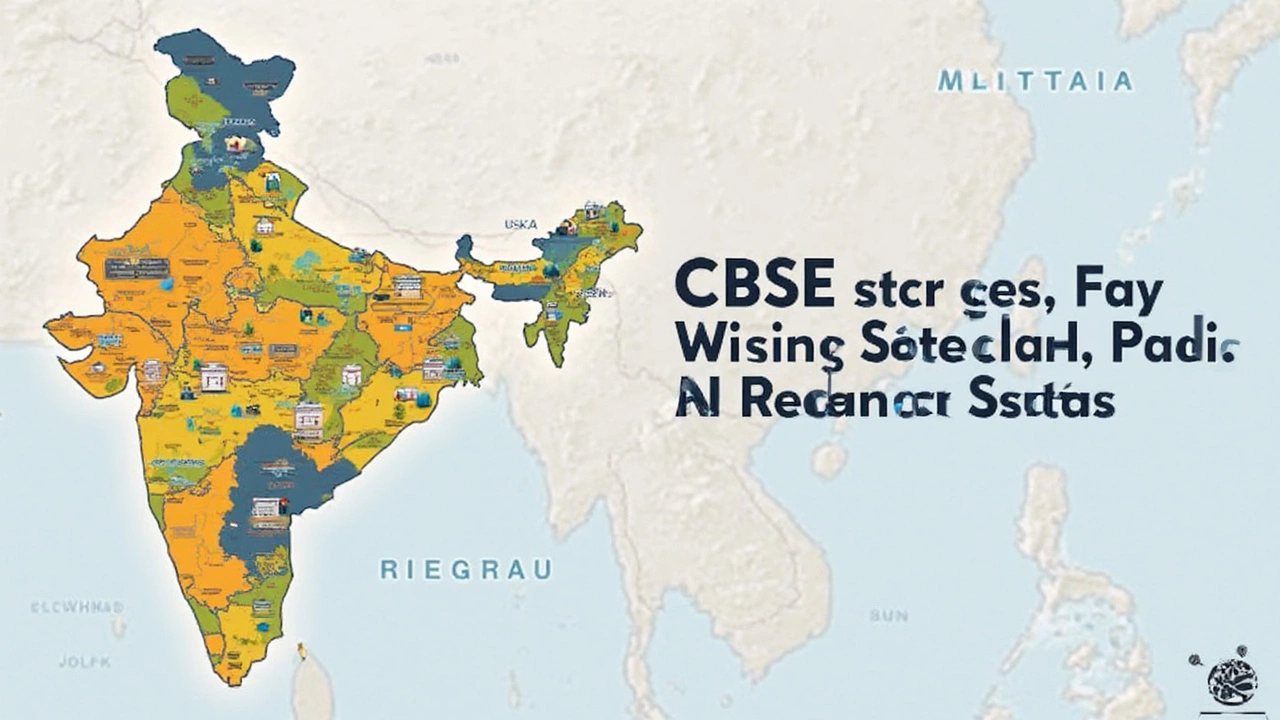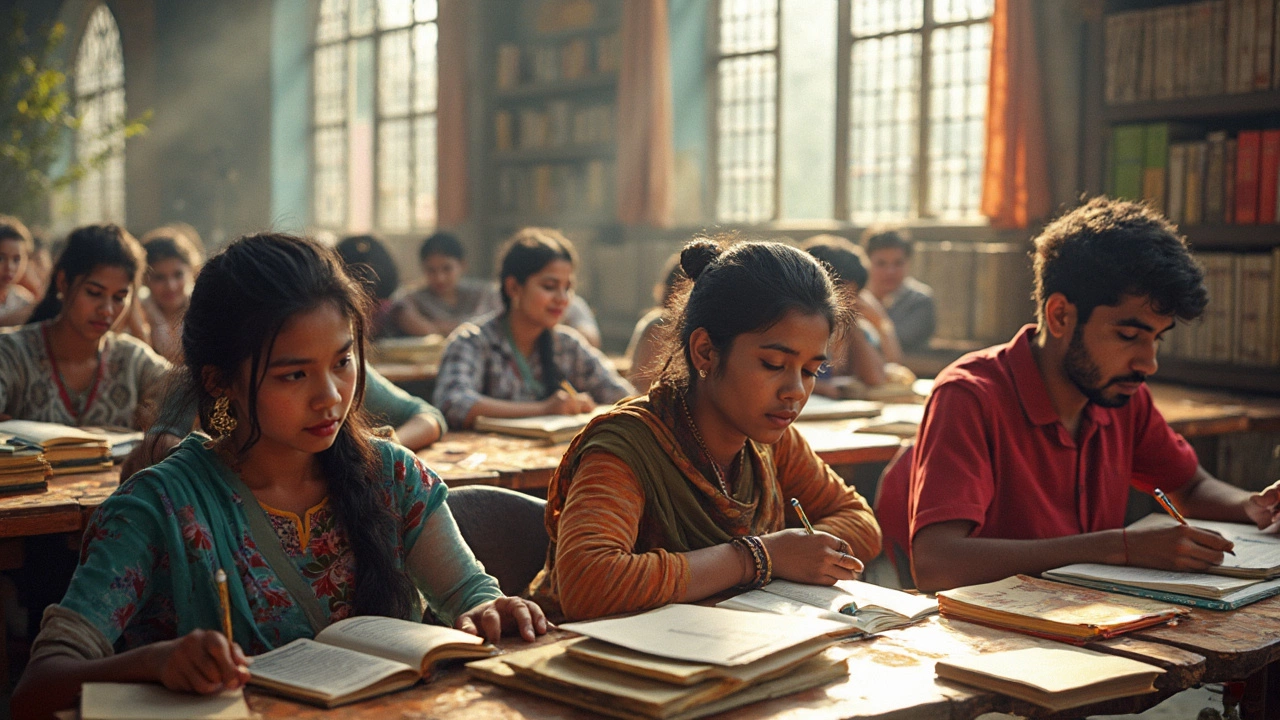Ever wondered where in India you'll find the most CBSE schools? Well, Uttar Pradesh holds the crown. With over 6,000 CBSE-affiliated schools, it's not just about the numbers; the state showcases a serious commitment to standardized education. But why does UP have so many? It’s simple: the massive population needs a lot of schools, and CBSE's curriculum is a hit with parents.
The Central Board of Secondary Education, or CBSE for short, is like the big boss of Indian school curriculums, known for its consistent syllabus across the country. This makes it easier for kids who need to move states — no nasty surprises in the syllabus that way. Plus, CBSE caters well to students aiming for national competitive exams like NEET or JEE. So, it's not a shocker that many parents want CBSE for their kids.
- An Overview of CBSE in India
- Leading State in CBSE Schools
- Factors Behind the Numbers
- Why Choose a CBSE School?
- Tips for Selecting the Right School
An Overview of CBSE in India
The Central Board of Secondary Education (CBSE) is one of India's biggest and most influential educational boards, responsible for shaping the academic journey of millions of students. This board operates under the Union Government of India, which helps it maintain a consistent and standardized education system across the country. It’s particularly popular for its scientific approach to education. Emphasizing core subjects and skill development, CBSE is a go-to option for many.
You’ll find that most CBSE-affiliated schools follow a curriculum that aims to lay a strong foundation for students aspiring to crack national-level competitive exams, like IIT entrance tests or NEET for medical students. This focus on objective knowledge makes CBSE a preferred choice among parents wanting the best study opportunities for their children.
CBSE schools in India are rampant across urban areas, with a sizable chunk catering to the rising demand in rural regions too. The syllabus is crafted in such a way that it aids in better preparation for higher education both in India and abroad.
To give an idea of its widespread presence, let's take a snapshot of the statistics from 2024:
| State | Number of Schools |
|---|---|
| Uttar Pradesh | 6,000+ |
| Maharashtra | 1,400+ |
| Delhi | 1,900+ |
This fast expansion is not just a reflection of the board’s reach but also an understanding of the needs across different regions. So, whether you're in a bustling metro or a quieter town, chances are there’s a good CBSE school nearby.
Leading State in CBSE Schools
Uttar Pradesh is the big name when it comes to CBSE schools in India. With over 6,000 schools under the CBSE umbrella, it’s way ahead of other states. This isn’t just a random fact; it shows a pretty interesting trend about how education is structured in India.
Why does Uttar Pradesh lead the pack? A huge factor is population. It's the most populated state in India, which means lots of kids need schools. Naturally, the number of schools would be higher, and CBSE schools are a popular choice for many families. Plus, cities like Lucknow and Noida are major hubs with a growing middle class that values high-standard education.
The competition in the educational sector in UP is fierce. Schools strive to get that shiny CBSE affiliation because it’s often seen as a mark of quality education and also attracts more students. The CBSE syllabus is uniform and structured, which makes it a hit among parents who want a reliable and consistent education for their kids.
There's also a trend where CBSE schools in UP have a stronger focus on prepping students for competitive exams. That’s a big deal since many students aim for national-level exams like NEET and JEE. These schools ramp up their coaching to get students exam-ready, which in turn heightens their appeal.
Below is a quick comparison of CBSE school numbers in some Indian states:
| State | Number of CBSE Schools |
|---|---|
| Uttar Pradesh | 6,000+ |
| Maharashtra | 4,000+ |
| Delhi | 1,300+ |
| Karnataka | 1,200+ |
The state’s emphasis on infrastructure and educational growth further contributes to this lead. And with continuous governmental support pushing for better education, it looks like UP will keep holding onto its CBSE crown for a while.

Factors Behind the Numbers
So, why does Uttar Pradesh have so many CBSE schools? It's not just a coincidence. First off, UP is the most populated state in India, which naturally means more kids, hence more schools. Pretty straightforward math, right?
Then, there's the preference thing. CBSE schools are super popular because they offer a standardized education. With parents keen on enrolling their kids in a system that's almost universal across India, the demand for CBSE-affiliated schools has shot up. Plus, UP government policies have been pretty supportive, encouraging educational institutions to align with CBSE standards.
Let's not forget about infrastructure. UP has been upping its game with improved facilities and resources. This has turned the state into a hub for educational advancement. School managements find it lucrative to set up here because of the enthusiastic response from parents and students.
Also, the CBSE itself has made it easier to affiliate with them. Streamlining the process means more schools can join the board without too many hoops. This facilitates expansion and allows numerous existing schools in UP to switch over or start new CBSE entities.
Lastly, there’s a bonus for students aiming for national-level exams. CBSE’s syllabus aligns well with many entrance exams for engineering and medicine, studying in a CBSE school positions students pretty well. Knowing this, many educators choose UP as their base to tap into the large student demographic aiming for these exams.
In a nutshell, it’s a mix of population, preference, and policy that makes UP the king of education here. Isn’t it interesting how interconnected these factors are?
Why Choose a CBSE School?
So, you're thinking about enrolling your kid in a CBSE school? It’s not a bad move, considering that CBSE schools are plenty and have quite a rep in the country. One of the big draws is the standardized education across India. Whether you're in a bustling city like Mumbai or a quieter district like Kanpur, the curriculum stays the same. This means if your family moves, your child won't have to catch up on completely new material, which is a huge relief!
CBSE's syllabuses are pretty well-structured, concentrating on key subjects like Maths, Science, and English, which serve as strong foundations for various national level competitive exams like NEET and JEE. It’s no wonder they are a favorite for students aiming for careers in engineering or medicine.
Parents choose CBSE for its balanced focus on academics and extracurriculars. The board stresses physical education, arts, and critical thinking, which helps shape well-rounded students. Plus, the stress on English not only helps with competitive exams but also preps students for global opportunities.
As for those worrying about affordability, you might find CBSE schools on various budget scales. Sure, some come with hefty fees, but many offer quality education without burning a hole in the pocket. Especially in states with many CBSE schools, like Uttar Pradesh, there's likely a school that fits your family’s needs and budget.

Tips for Selecting the Right School
Choosing the perfect school for your kids is no small feat, especially with so many CBSE schools out there. You want to make sure you're not just going with the crowd but picking the one that fits your family's specific needs. Here’s a handy guide to keep you on track.
First off, think about the location. You don't want your child spending more time traveling than learning. A nearby school can make your life easier and give your child more time for homework and play.
Next, dive into the school's reputation. Ask around, check online reviews, and visit the school if possible. It’s like dating — you want to make sure it’s a good match before you commit. You should also consider the school's past exam results and see how their students generally fare in important exams like the NEET or JEE. Many CBSE aspirants want a school where students shine in these exams.
Check the faculty's credentials. Are they experienced and well-qualified? Good teachers are a crucial part of the deal. Meet with them if you can and get a feel for how they interact with students.
- Average class size: Smaller classes often mean more attention for your child. Find out the usual student-to-teacher ratio.
- Infrastructure: Look for a place that's well-equipped. Libraries, labs, and sports facilities are essential for a holistic education.
- Extra-curricular activities: See what the school offers beyond the textbook. Music, sports, drama — activities like these can make school life more interesting and help kids develop diverse skills.
If you can, have a chat with parents of current students. They can give you the real scoop on what goes on during school hours and whether the school lives up to its promises.
Finally, consider the fees. Education is an investment, but you don’t want to break the bank. Ensure that the fees align with your budget without compromising quality.
Here's a little tip: You can also use official CBSE directories to verify school accreditations, ensuring the school's credentials are legit.
| Key Consideration | Importance |
|---|---|
| Location | High |
| Reputation | Very High |
| Faculty Quality | High |
| Class Size | Moderate |
| Fees | Moderate |
By considering these factors, you’ll be well on your way to picking the right CBSE school that sets your child up for success. Good luck!



